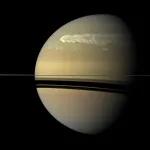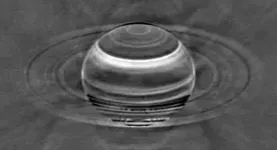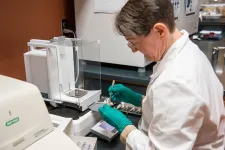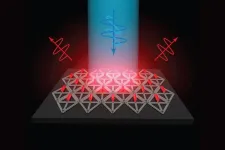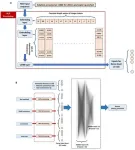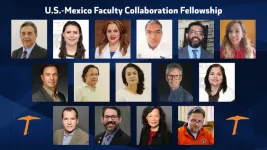(Press-News.org) The largest storm in the solar system, a 10,000-mile-wide anticyclone called the Great Red Spot, has decorated Jupiter's surface for hundreds of years.
A new study now shows that Saturn — though much blander and less colorful than Jupiter — also has long-lasting megastorms with impacts deep in the atmosphere that persist for centuries.
The study was conducted by astronomers from the University of California, Berkeley, and the University of Michigan, Ann Arbor, who looked at radio emissions from the planet, which come from below the surface, and found long-term disruptions in the distribution of ammonia gas.
The study was published today (Aug. 11) in the journal Science Advances.
Megastorms occur approximately every 20 to 30 years on Saturn and are similar to hurricanes on Earth, although significantly larger. But unlike Earth's hurricanes, no one knows what causes megastorms in Saturn's atmosphere, which is composed mainly of hydrogen and helium with traces of methane, water and ammonia.
“Understanding the mechanisms of the largest storms in the solar system puts the theory of hurricanes into a broader cosmic context, challenging our current knowledge and pushing the boundaries of terrestrial meteorology,” said lead author Cheng Li, a former 51 Peg b Fellow at UC Berkeley who is now an assistant professor at the University of Michigan.
Imke de Pater, a UC Berkeley professor emerita of astronomy and of earth and planetary sciences, has been studying gas giants for over four decades to better understand their composition and what makes them unique, employing the Karl G. Jansky Very Large Array in New Mexico to probe the radio emissions from deep inside the planet.
“At radio wavelengths, we probe below the visible cloud layers on giant planets. Since chemical reactions and dynamics will alter the composition of a planet’s atmosphere, observations below these cloud layers are required to constrain the planet’s true atmospheric composition, a key parameter for planet formation models,” she said. “Radio observations help characterize dynamical, physical and chemical processes including heat transport, cloud formation and convection in the atmospheres of giant planets on both global and local scales.”
As reported in the new study, de Pater, Li and UC Berkeley graduate student Chris Moeckel found something surprising in the radio emissions from the planet: anomalies in the concentration of ammonia gas in the atmosphere, which they connected to the past occurrences of megastorms in the planet’s northern hemisphere.
According to the team, the concentration of ammonia is lower at midaltitudes, just below the uppermost ammonia-ice cloud layer, but has become enriched at lower altitudes, 100 to 200 kilometers deeper in the atmosphere. They believe that the ammonia is being transported from the upper to the lower atmosphere via the processes of precipitation and reevaporation. What’s more, that effect can last for hundreds of years.
The study further revealed that although both Saturn and Jupiter are made of hydrogen gas, the two gas giants are remarkably dissimilar. While Jupiter does have tropospheric anomalies, they have been tied to its zones (whitish bands) and belts (darkish bands) and are not caused by storms like they are on Saturn. The considerable difference between these neighboring gas giants is challenging what scientists know about the formation of megastorms on gas giants and other planets and may inform how they’re found and studied on exoplanets in the future.
The National Radio Astronomy Observatory (NRAO) is a facility of the National Science Foundation, operated under cooperative agreement by Associated Universities Inc.
END
Hundred-year storms? That's how long they last on Saturn.
Megastorms leave marks on Saturn’s atmosphere for centuries
2023-08-11
ELSE PRESS RELEASES FROM THIS DATE:
New concussion headset shows when it's safe to return to play
2023-08-11
A new digital headset designed to measure alterations in brain function could change decisions about how quickly an athlete is ready to return to play after a concussion. In an evaluation of the device, UC San Francisco researchers found it revealed brain changes even in athletes whose concussion symptoms had gone away, suggesting they could be playing too soon.
Although not yet approved by the Food and Drug Administration (FDA), the device could fill an important niche among athletes, clinicians, trainers and coaches, who are concerned about the long-term effects of repeated sports-related concussions. These include chronic traumatic encephalopathy, ...
CORRECTION: Outdoor air pollution may increase non-lung cancer risk in older adults
2023-08-11
*This press release was amended on August 9, 2023. Due to a mistake in interpretation of data, the previous version of the release stated the study found that NO2 exposure is associated with a decreased risk of breast cancer. The authors have confirmed that the results showed that NO2 exposure is associated with an increased risk of breast cancer.
Key points:
A cohort study of millions of Medicare beneficiaries found that chronic exposures to PM2.5 and NO2 over a 10-year period increased the risk of developing colorectal and prostate cancers.
Even in areas with low pollution levels, researchers found substantial associations between exposures to ...
Zhong named Institute of Food Technologists fellow
2023-08-11
Qixin Zhong, professor in the University of Tennessee Department of Food Science, has been named an Institute of Food Technologists (IFT) Fellow.
The honor was bestowed as a result of Zhong’s years of contribution to food science and to IFT through his scientific, engineering and leadership efforts. In his research enhancing food quality, safety and healthfulness, Zhong creates multilength scale structures to improve the function of food ingredients. His cutting-edge innovations and research developments have impacted countless producers and consumers.
Zhong says he is honored to be named a Fellow, and ...
University of Tennessee extension wins “Employer of the Year” from international organization
2023-08-11
Ask just about any person in the University of Tennessee Extension family what they like about their job, and they might mention the impact they have in their communities and the people they help. Long thought of as a career where you can realize a calling for service, an international organization now confirms what many employees have believed for some time – that UT Extension is a great place to work.
The International Association of Administrative Professionals (IAAP) has named UT Extension as its 2023 Employer of the Year. This ...
Interdisciplinary team studies decomposition effects on soil
2023-08-11
Forensic researchers at the University of Tennessee Knoxville’s famous Anthropological Research Facility, popularly known as the “Body Farm,” have made headlines for decades in their discoveries of what happens to human bodies after death. Now, a multidisciplinary team—engineers, soil scientists, and biologists—digs in with them for a deeper look at what happens to the soil underneath a decomposing body. Their study, “Soil Elemental Changes During Human Decomposition,” published in June 2023 by PLOS One, could benefit investigators searching for human remains in remote or hard-to access-vegetated areas.
“This ...
Arrays of quantum rods could enhance TVs or virtual reality devices
2023-08-11
Cambridge, MA – Flat screen TVs that incorporate quantum dots are now commercially available, but it has been more difficult to create arrays of their elongated cousins, quantum rods, for commercial devices. Quantum rods can control both the polarization and color of light, to generate 3D images for virtual reality devices.
Using scaffolds made of folded DNA, MIT engineers have come up with a new way to precisely assemble arrays of quantum rods. By depositing quantum rods onto a DNA scaffold in a highly controlled way, the researchers can regulate their orientation, which is a key factor in determining the polarization of light emitted by the array. This makes it easier ...
Artificial intelligence designs advanced materials
2023-08-11
In a world where annual economic losses from corrosion surpass 2.5 trillion US Dollars, the quest for corrosion-resistant alloys and protective coatings is unbroken. Artificial intelligence (AI) is playing an increasingly pivotal role in designing new alloys. Yet, the predictive power of AI models in foreseeing corrosion behaviour and suggesting optimal alloy formulas has remained elusive. Scientists of the Max-Planck-Institut für Eisenforschung (MPIE) have now developed a machine learning model that enhances the predictive accuracy by up to 15% compared to existing frameworks. This model uncovers new, but realistic corrosion-resistant alloy compositions. ...
Even treated wastewater affects our rivers
2023-08-11
Effluents from wastewater treatment plants have a dual effect: Some species disappear, while others benefit. Especially certain insect orders, such as stonefly and caddisfly larvae, are decimated. Certain worms and crustaceans, by contrast, can increase in number. A team from Goethe University Frankfurt led by Daniel Enns and Dr. Jonas Jourdan has corroborated this in a comprehensive study, which has now been published in the journal Water Research. They examined 170 wastewater treatment plants in Hesse in relation to species composition.
Wastewater treatment plants are ...
Study: Infant formula safety checks can be improved with stratified sampling
2023-08-11
URBANA, Ill. – Producers of infant formula employ comprehensive food safety systems, including product testing to ensure those systems are working. A new study from the University of Illinois Urbana-Champaign finds that some testing methods are more powerful at catching contaminants than others.
Spacing out samples over time in a stratified sampling pattern is better at catching risky pathogens like Cronobacter than randomly sampling from the product as it is being produced, the researchers found. Furthermore, while taking more samples of product generally increases the chance to catch the pathogen, there is a point after which it ...
UTEP launches new research partnerships with Chihuahua universities
2023-08-11
EL PASO, Texas (Aug. 11, 2023) – How are our region’s pecan farms affected by drought? Is there a better way to address domestic violence in Ciudad Juárez? These are a few of the big questions scientists are asking as they prepare to embark on a new cross-border research collaboration.
Created by The University of Texas at El Paso, the U.S.-Mexico Faculty Collaboration Fellowship program will support research projects with higher education institutions in the State of Chihuahua to spur studies on issues ...
LAST 30 PRESS RELEASES:
Jeonbuk National University researchers develop novel dual-chemical looping method for efficient ammonia synthesis
New study sheds light on stroke recovery via exercise-induced migration of mitochondria
SEOULTECH researchers develop sodium-based next-generation smart electrochromic windows
Data-driven analysis reveals three archetypes of armed conflicts
Heart disease, stroke deaths down, yet still kill more in US than any other cause
Light switches made of ultra-thin semiconductor layers
Creative talent: has AI knocked humans out?
Sculpting complex, 3D nanostructures with a focused ion beam
A year after undermining Bredt’s rule, UCLA scientists have made cage-shaped, double-bonded molecules that defy expectations
Human activities drive global dryland greening
PeroCycle announces new appointments as it builds a world-class board for meaningful climate impact
Magnetic avalanches power solar flares
LeapSpace goes live: the Research-Grade AI-Assisted Workspace built on trusted science
DNA tests reveal mysterious beluga family trees
Strategic sex: Alaska’s beluga whales swap mates for long-term survival
How early cell membranes may have shaped the origins of life
Cannabis legalization is driving increases in marijuana use among U.S. adults with historically lower consumption rates
Multifunctional dipoles enabling enhanced ionic and electronic transport for high‑energy batteries
Triboelectric nanogenerators for future space missions
Advancing energy development with MBene: Chemical mechanism, AI, and applications in energy storage and harvesting
Heteroatom‑coordinated Fe–N4 catalysts for enhanced oxygen reduction in alkaline seawater zinc‑air batteries
Meta-device for precision lateral displacement sensing
Plasma-guided mitotane for the treatment of adrenocortical carcinoma: adjuvant care to advanced disease
Theoretical study of laser-enhanced nuclear fusion reactions
Social environment impacts sleep quality
Optimized kinetic pathways of active hydrogen generation at Cu2O/Cu heterojunction interfaces to enhance nitrate electroreduction to ammonia
New design playbook could unlock next generation high energy lithium ion batteries
Drones reveal how feral horse units keep boundaries
New AI tool removes bottleneck in animal movement analysis
Bubble netting knowledge spread by immigrant humpback whales
[Press-News.org] Hundred-year storms? That's how long they last on Saturn.Megastorms leave marks on Saturn’s atmosphere for centuries
